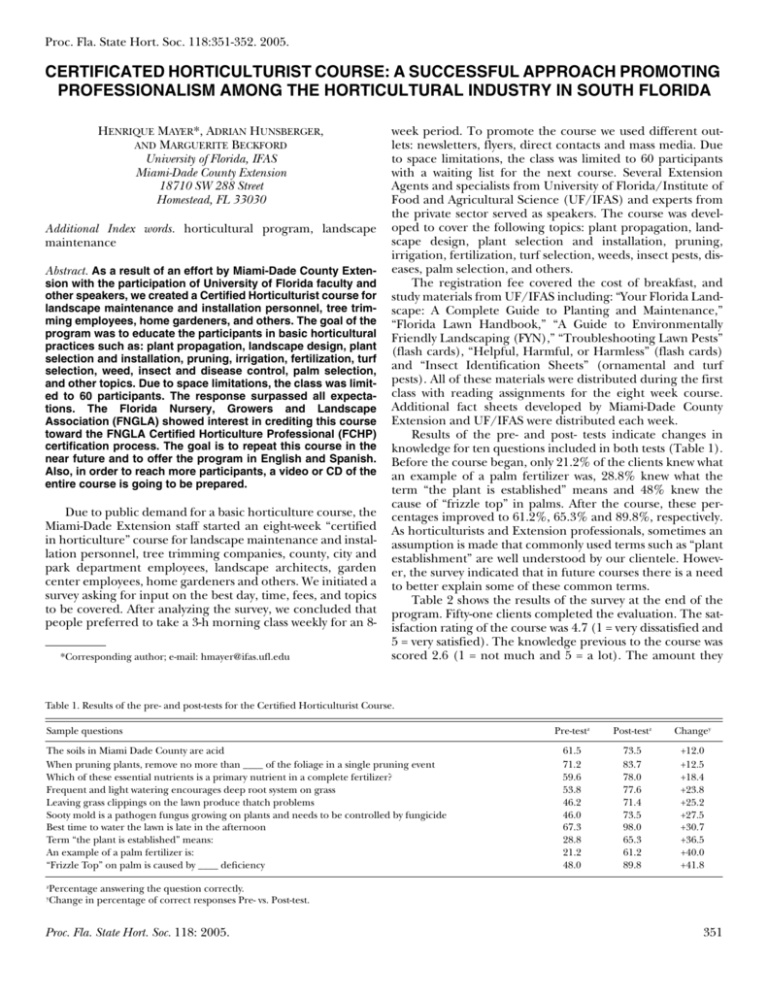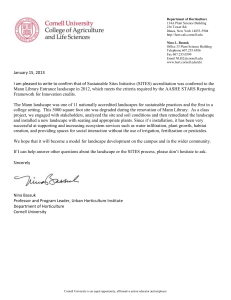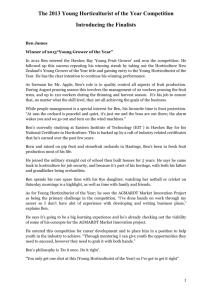Certificated horticulturist course: A successful approach promoting
advertisement

Proc. Fla. State Hort. Soc. 118:351-352. 2005. CERTIFICATED HORTICULTURIST COURSE: A SUCCESSFUL APPROACH PROMOTING PROFESSIONALISM AMONG THE HORTICULTURAL INDUSTRY IN SOUTH FLORIDA HENRIQUE MAYER*, ADRIAN HUNSBERGER, AND MARGUERITE BECKFORD University of Florida, IFAS Miami-Dade County Extension 18710 SW 288 Street Homestead, FL 33030 Additional Index words. horticultural program, landscape maintenance Abstract. As a result of an effort by Miami-Dade County Extension with the participation of University of Florida faculty and other speakers, we created a Certified Horticulturist course for landscape maintenance and installation personnel, tree trimming employees, home gardeners, and others. The goal of the program was to educate the participants in basic horticultural practices such as: plant propagation, landscape design, plant selection and installation, pruning, irrigation, fertilization, turf selection, weed, insect and disease control, palm selection, and other topics. Due to space limitations, the class was limited to 60 participants. The response surpassed all expectations. The Florida Nursery, Growers and Landscape Association (FNGLA) showed interest in crediting this course toward the FNGLA Certified Horticulture Professional (FCHP) certification process. The goal is to repeat this course in the near future and to offer the program in English and Spanish. Also, in order to reach more participants, a video or CD of the entire course is going to be prepared. Due to public demand for a basic horticulture course, the Miami-Dade Extension staff started an eight-week “certified in horticulture” course for landscape maintenance and installation personnel, tree trimming companies, county, city and park department employees, landscape architects, garden center employees, home gardeners and others. We initiated a survey asking for input on the best day, time, fees, and topics to be covered. After analyzing the survey, we concluded that people preferred to take a 3-h morning class weekly for an 8*Corresponding author; e-mail: hmayer@ifas.ufl.edu week period. To promote the course we used different outlets: newsletters, flyers, direct contacts and mass media. Due to space limitations, the class was limited to 60 participants with a waiting list for the next course. Several Extension Agents and specialists from University of Florida/Institute of Food and Agricultural Science (UF/IFAS) and experts from the private sector served as speakers. The course was developed to cover the following topics: plant propagation, landscape design, plant selection and installation, pruning, irrigation, fertilization, turf selection, weeds, insect pests, diseases, palm selection, and others. The registration fee covered the cost of breakfast, and study materials from UF/IFAS including: “Your Florida Landscape: A Complete Guide to Planting and Maintenance,” “Florida Lawn Handbook,” “A Guide to Environmentally Friendly Landscaping (FYN),” “Troubleshooting Lawn Pests” (flash cards), “Helpful, Harmful, or Harmless” (flash cards) and “Insect Identification Sheets” (ornamental and turf pests). All of these materials were distributed during the first class with reading assignments for the eight week course. Additional fact sheets developed by Miami-Dade County Extension and UF/IFAS were distributed each week. Results of the pre- and post- tests indicate changes in knowledge for ten questions included in both tests (Table 1). Before the course began, only 21.2% of the clients knew what an example of a palm fertilizer was, 28.8% knew what the term “the plant is established” means and 48% knew the cause of “frizzle top” in palms. After the course, these percentages improved to 61.2%, 65.3% and 89.8%, respectively. As horticulturists and Extension professionals, sometimes an assumption is made that commonly used terms such as “plant establishment” are well understood by our clientele. However, the survey indicated that in future courses there is a need to better explain some of these common terms. Table 2 shows the results of the survey at the end of the program. Fifty-one clients completed the evaluation. The satisfaction rating of the course was 4.7 (1 = very dissatisfied and 5 = very satisfied). The knowledge previous to the course was scored 2.6 (1 = not much and 5 = a lot). The amount they Table 1. Results of the pre- and post-tests for the Certified Horticulturist Course. Sample questions The soils in Miami Dade County are acid When pruning plants, remove no more than ____ of the foliage in a single pruning event Which of these essential nutrients is a primary nutrient in a complete fertilizer? Frequent and light watering encourages deep root system on grass Leaving grass clippings on the lawn produce thatch problems Sooty mold is a pathogen fungus growing on plants and needs to be controlled by fungicide Best time to water the lawn is late in the afternoon Term “the plant is established” means: An example of a palm fertilizer is: “Frizzle Top” on palm is caused by ____ deficiency z y Pre-testz Post-testz Changey 61.5 71.2 59.6 53.8 46.2 46.0 67.3 28.8 21.2 48.0 73.5 83.7 78.0 77.6 71.4 73.5 98.0 65.3 61.2 89.8 +12.0 +12.5 +18.4 +23.8 +25.2 +27.5 +30.7 +36.5 +40.0 +41.8 Percentage answering the question correctly. Change in percentage of correct responses Pre- vs. Post-test. Proc. Fla. State Hort. Soc. 118: 2005. 351 Table 2. Evaluation of the Certified Horticulturist Course. Category nz Previous knowledgey Amount learnedx Practice changew Government employee Parks & Recreation Landscaper Landscape maintenance Nurseryman Homeowner Botanical gardener Average Satisfaction rating of the courseu—4.7 7 9 8 6 6 13 2 51v 2.7 2.4 3.1 2.7 2.7 2.2 4.5 2.6 4.7 4.4 4.6 3.8 4.0 4.8 5.0 4.5 4.6 4.0 3.4 3.5 3.5 4.1 2.5 3.8 z n = Number of participants. 1 = not much, 2 = a little bit, 3 = some, 4 = a fair amount, 5 = a lot. x1 = nothing, 2 = a few things, 3 = some things, 4 = many things, 5 = lots of things. w1 = no changes, 2 = a few changes, 3 = some changes, 4 = many changes, 5 = lots of changes. vTotal number of participants. u1 = very dissatisfied, 2 = dissatisfied, 3 = neutral, 4 = satisfied, 5 = very satisfied. y learned after the course was scored 4.5 (1 = nothing and 5 = lots of things). The score for practice changes was 3.8 (1 = no changes and 5 = lots of changes). Ninety percent of the participants stated that this course will help them in their job or future job. When we asked the participants to rank their sources for plant information in the order of importance, the Extension Service was ranked #1 by government, parks, landscaper and landscape maintenance personnel. Books were ranked first by nursery people, homeowners and garden center personnel. Chemical suppliers were ranked first by botanical garden employees. In order to obtain the “certificate of completion,” participants needed to have a passing grade of 80% or higher on the final exam which was offered as an open book, take home exam. The average grade was 90.5% with 77% of the participants earning a passing grade. One of the challenges encountered was that some participants worked on the final exam in groups. In these cases, the participants needed to re-take a different 50-question open book exam at the 352 Extension office. Forty certificates of completion and six certificates of participation were awarded and there are another six participants who retook the final exam. After completion of the course Continuing Education Units (CEUs) were awarded for arborists, landscape architects and pesticide licensee holders. After 6 months, a follow-up survey will be conducted to learn what practice changes have actually been made. There is a huge demand for basic horticulture courses. With some grant money a manual with a CD of all the presentations and study materials that can be used by Extension agents and County agencies can be developed. The MiamiDade Parks and Recreation Department is interested in using these materials for basic training for its employees. Many clients showed interest in the development of a Spanish version of this course. This is going to be a challenge for the future due to the translation effort and the development of new materials. In conclusion, we filled a niche not covered by any institution in the County. Proc. Fla. State Hort. Soc. 118: 2005.








